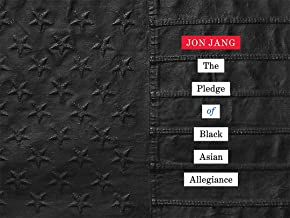Pianist-composer-bandleader Jon Jang is no newcomer to social justice issues, he’s taken up the mantle of human rights through his music, personal outlook & attitude, and in action for many seasons. Jon’s latest recording is certainly in the moment, exploring the historic interconnections and the current burning need for alliances between the African American and Asian American communities, titled The Pledge of Black/Asian Allegiance. Clearly some questions were in order for this deeply thoughtful, Bay Area-based artist.
What is your sense of the “Black Asian Allegiance” here in the 21st Century?
Thank you for having me Willard. As Malcolm X once said, “If you were born black, you were born in jail.” Black people in America have been enslaved 250 years and longer than they have been free. Black people built this country and it’s all in the poem, Why is We Americans? by Amiri Baraka.
Black people in America have been at the forefront in the struggle against systemic racism. From Frederick Douglass fighting against Chinese exclusion and fighting for Chinese immigrant rights to become US citizens to the Congressional Black Caucus standing first in line to support redress and reparations for Japanese Americans, black leaders have given strong ally-ship to Asian Americans.
How can Asian Americans become real allies to African Americans? First, we have to open up conversations and share each of our stories and histories.
Because Asian immigrant families have moved into black communities, there are tensions in the communities because both communities lack an understanding of each other’s history. There is also the problem of erasure. When I spoke at an African American art course at a university on the East Coast a few years ago, none of the black students knew anything about Nat Turner. I had a Chinese American Stanford University student who was born in the Philippines and didn’t know about the history of the Chinese workers who built the first transcontinental railroad hired by Stanford nor about the Chinese Exclusion Act of 1882, the first legislation to ban Chinese immigrants solely on the basis of race.
During the 1970s, Asian Americans primarily Japanese Americans, Chinese Americans, Pilipino Americans and Korean Americans, developed a political consciousness inspired by the struggles of the Black Liberation Movement and the Civil Rights Movement which led to the birth of the Asian American Movement in solidarity with black, brown and red peoples.
Since the passage of the Immigration and Nationality Act of 1965, the United States has become more complicated because there is a more diverse population. Added to the Asian American four groups that I mentioned earlier, now we have Southeast Asians and South Asians and within those groupings there are sub groupings such as Vietnamese, Cambodian, Burmese. There are also class differences among and within these groups
Now that I am considered an elder OG (Original Gangsta) by Generation Y and Z Asian American activists, the younger generations face different circumstances and challenges. Their grandparents and parents may be immigrants who live in the same space. Their parents were taught, if taught at all, the American history from a white perspective and buy into the American Dream myth of equal opportunity. Young activist peers may also buy into that as well. There are Asian Americans who buy into the Model Minority myth created by White America to invalidate systemic racism of black and Latinx peoples.
About twenty years ago, Professor Claire Jean Kim developed the racial triangulation theory, which is based on the idea that race is a multidimensional field of positions that merges relative value and civic inclusion. The first example of racial triangulation occurred when Chinese were imported to avoid hiring newly freed blacks in the Reconstruction era. White Supremacist America applied the Model Minority trick when they praised Chinese immigrants for their supposed work ethic in contrast to white America’s stereotyping black people as lazy. I don’t remember a children’s song about the Chinese building the railroad, but I certainly remember John Henry.
In this moment, it is imperative that Asian Americans support H.R. 40 The Commission to Study and Develop Reparations Proposals for African American Act. Asian Americans must also support defunding the police to re-allocate funding and resources into providing free healthcare to black people, especially in the research and treatment of diabetes. Remember Eric Dolphy!
One of the lessons I learned from my mentors Wendell Logan and Bernice Johnson Reagon is that building Black Asian solidarity or any kind of solidarity between two or more distinctly different races of people takes time, patience, trust, troubled love and the ability to withstand discomfort. Solidarity doesn’t magically happen like in that song that I detest called We Are the World
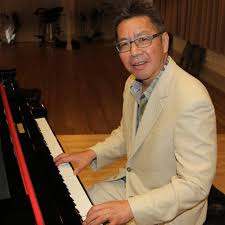
You open the album with the piece “Yuri Kochiyama, Malcolm X!” Talk about the correlation of those two figures.
Yuri Kochiyama, a few years older than Malcolm X, invited Malcolm to her family apartment located in Harlem in October 1963. Yuri admired Malcolm from afar and was excited that he consented to her invitation. Yuri, her husband Bill and their six children had planned a gathering of Hibakusha women, survivors of the Atomic bomb in Hiroshima-Nagasaki who were writing about stories about their struggle and survival. Malcolm was a black revolutionary nationalist who was evolving into a black revolutionary internationalist. He spoke eloquently about Chinese American transnational history. Yuri, an integrationist, later evolved into a revolutionary internationalist and joined Malcolm’s Organization of Afro-American Unity as one of the few Asian American activists. Yuri Kochiyama made history. This diminutive Nisei (second generation Japanese American) woman was the nail that sticks up! To place that moment in its proper context, this came at a time before the birth of the term Asian American by UC Berkeley Asian American student activists and before the birth of the Asian American Movement in 1969. For the most part, Asian Americans were categorized as “Other” and often derisively called Orientals by white America.
After Malcolm X was assassinated in February 1965, I think Malcolm planted the seeds and transmitted his legacy to Yuri, as well as others. In my opinion as an artist/activist during the 1980s, Yuri Kochiyama carried Malcolm’s legacy through the lens of black revolutionary internationalism. It wasn’t so much of an identity thing for Yuri. She wasn’t trying to be black. Yuri was carrying part of the work envisioned by Malcolm X. In the composition, the 9 pitch melody performed by the saxophone and trombone is based on the 9 syllables of Yuri and Malcolm’s names.
Please illuminate your thinking as you wrote the 8 thematic originals you contributed to this recording.
The recording opens with two excerpts from my newly commissioned work, The Pledge of Black Asian Allegiance, Yuri Kochiyama, Malcolm X is a hybrid of Soran Bushi, the Japanese fishermen’s song from Hokkaido, and Bob Marley and Peter Tosh’s Get Up! Stand Up! I was inspired by Billy Harper’s unique rendering of Soran Bushi, on The Awakening the live recording of the Billy Harper Quintet in Paris in 1979, as well as Hitomi Oba’s unique rendition. 1973 was the pivotal year that I made the crucial decision to pursue music at the late age of 19 through Rahsaan Roland Kirk, Bruce Lee, McCoy Tyner and Bob Marley.
The second excerpt, The Nail That Sticks Up!, is dedicated to Yuri. It is inspired by Max Roach’s The Dream where Max performs a two part invention with the pre-recorded, I Have a Dream speech by Dr. Martin Luther King Jr. at the March on Washington in August 1963. I took a pre-recorded speech by Yuri Kochiyama about the history of black leaders supporting Asian Americans
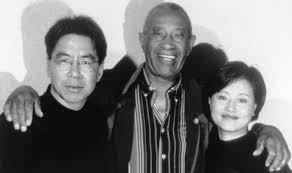
Yank Sing Work Song is dedicated to the Yank Sing Restaurant workers, victims of wage theft and management abuse who won a 4 million dollar settlement. Min Xiao Fen, the virtuoso pipa (Chinese lute) performer, opens with a Cantonese (southern Chinese) melody while the double bass is playing a figure which is a hybrid of slow black funk and Cantonese. Inspired by Miles Davis Bitches Brew recording, the rhythm section shifts to a faster tempo.
Jasmine Among the Magnolias is based on Beautiful Jasmine Flowers (Mo Li Hu), the first Chinese folk song brought over to the United States in 1800. Our unique treatment is a hybrid of this popular Chinese song within a contemporary black gospel ballad context. The work pays tribute to Frederick Douglass and Senator Blanche Kelson Bruce who fought for Chinese immigrant rights to become US citizens.
Flower Drum Song (Fengyang Hua Gu) has been considered among the most well-known Chinese traditional songs. Flower Drum Song originated from the Anhui Province, an area in east-central China known for its long history of suffering of poverty and famine during the Ming Dynasty (1368-1644 A.D.). The Flower Drum Song featured a husband and wife duo that “begged” and earned money by performing the Flower Drum Song and dance. The wife performed also on a small “flower” drum and the husband on gong. Similar to the black tradition of the “dozens,” the second part of the song featured a playful exchange of insults. Here is an example of the dozens in the Flower Drum Song, “My wife is ugly because she has big feet.” Here is an example of the dozens in the black tradition, “Your mama’s feet so big, she needs to wear a license plate.”
The next three works are part of a suite that I composed entitled, Can’t Stop Cryin’ for America: Black Lives Matter! commissioned by the San Francisco Arts Commission. The work is a collaboration with poet performer Dr. Amanda Kemp. The first piece, Hands Up! Don’t Shoot! pays homage to Michael Brown. The opening 14 note phrased is based on the 14 syllable phrase, “Hands up! Don’t shoot! I want to live! Hands up! Don’t shoot!
The second piece, More Motherless Children, pays homage to the nine black victims at the Emanuel AME Church in Charleston, South Carolina. I selected the black spiritual, Sometimes I Feel Like a Motherless Child, because six of the victims were mothers and grandmothers. Max Roach and Wendell Logan, who were two of my mentors, passed on this tradition to me. Max Roach recorded Motherless Child dedicated to Marcus Garvey on Max Roach’s recording, Lift Every Voice and Sing. When White American musicologist George Pullen Jackson stated that black spirituals were based on white hymns, Dr. Logan argued with the response, Sometimes I Feel Like a Motherless Child could not and did not come from a white hymn.
The third and final piece of Can’t Stop Cryin’ for America: Black Lives Matter! is entitled Why Did They Have to Shoot Him So Many Times? This work pays homage to Mario Woods, the 26 year black man who was shot twenty times and killed execution style by four San Francisco police officers. None of them were punished. During the process of composing Can’t Stop Cryin’ for America: Black Lives Matter!, there were more parts and the music sounded different. There was a part about Eric Garner and Laquan McDonald. But something happened. Poet performer Dr. Amanda Kemp, who has two black sons in their twenties, and I became depressed as we developed the work. Why Did They Have to Shoot Him So Many Times? changed from a piece about Mario Woods to a roll call and meditation of black victims legally lynched by the police.
Tell us about the musicians you chose to record this work.
First, multiple percussionist Deszon Claiborne and double bassist Gary Brown have performed in my ensembles for over a decade. I always search first for a rhythm section. In the book, Notes and Tones: Musician to Musician Interviews by drummer Art Taylor, Miles Davis was asked the question, “How do you go about picking a drummer for your band?” Miles replied, “First I look at my ding!” Miles explained the importance of a drummer’s reaction skill with what’s going on with the phrasing similar to the metaphor of a boxer. When Deszon and Gary perform the music, they performed with an attitude.
Saxophonist/composer Hitomi Oba and trombonist/composer Nick DePinna represent the latest group of musicians who have studied with my dear friend and collaborator James Newton. With James and me, it has been an unbroken thread where musicians who have studied with him such as Lenon Honor, Marcus Shelby, Hitomi and Nick have collaborated with me.
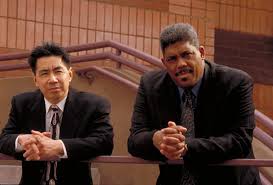
Jon & frequent collaborator flutist-composer James Newton
I saw a YouTube clip of Hitomi performing when she was in high school. Damn, she had a unique sound. She didn’t sound like what a jazz saxophonist should sound like. But she did. Maxine Hong Kingston taught me, “Learn to make your mind large, as large as the universe so there is room for paradox.”
I love performing with David Murray because he has such an original, honest sound. But that doesn’t mean he is not schooled in the tradition. I saw him give a lecture at the San Francisco Art Institute and he listed on the blackboard thirty important saxophonists such as Ben Webster, Coleman Hawkins, Sidney Bechet and Paul Gonsalves. David lectured and demonstrated their sonic contributions on his saxophone.
Now back to Hitomi, as well as Nick DePinna. Both of them have a very broad vision and their musicianship is on a very high level. Most important they have an attitude to advance the music driven by whatever it takes. I heard a work composed by Nick that was technically difficult. But it wasn’t technically difficult for the sake of being technically difficult. Like in many of James Newton’s works, it is about making an honest and truthful musical statement. “What can replace Opus?”
What was your sense of closing this album with “Butterfly Lovers Song” followed by the familiar theme “You’ll Never Walk Alone?”
During the 1980s, my unique rendering of the Butterfly Lovers Song was the outcome of my artist activist connections with various mass movement work such as the Jesse Jackson Presidential Campaign and the Rainbow Coalition, as well as the mass movement work in the Chinese Progressive Association (CPA). As a result, the Butterfly Lovers Song became a hybrid and merger of two different music traditions: black music and Chinese music.
Jesse Jackson was the first Presidential candidate to speak in San Francisco Chinatown. Jesse Jackson spoke on many occasions at Portsmouth Square. Jesse Jackson also addressed Asian American issues such as the Justice for Vincent Chin campaign and the anti-immigrant Simpson-Mazzoli Act. Whenever there was a space with a piano, Francis Wong and I would perform Country Preacher, which was the anthem for Reverend Jackson that was recorded live by the Cannonball Adderley Quintet in 1969 at an Operation Breadbasket event in Chicago hosted by the Southern Christian Leadership Conference.
In the Fall of 1988, the Chinese Progressive Association was planning to celebrate our 16th anniversary at the New Asia Restaurant in San Francisco Chinatown. Chinese Progressive Association director Mabel Teng requested that I learn to perform the Butterfly Lovers Song for the Chinese immigrant audience. Because I never heard of the song, I asked Mabel if she could give a recording of it. She didn’t have a recording
I was forced to haphazardly comb the merchant stores on Grant Avenue, the main street in San Francisco Chinatown in search of a cassette tape recording of the Butterfly Lovers Song. Because I did not speak Cantonese, the merchants could not understand what I was looking for. I tried flapping my arms like Morris Day and The Time performing The Bird to illustrate the butterfly flutter. Unfortunately, my bird flapping was too good as the merchant showed me a tape cassette recording cover of birds flying. A day before the banquet, a CPA member had a vinyl recording of the Butterfly Lovers Song to lend to me. By listening to the recording, I learned the song overnight.
After I performed the Butterfly Lovers Song at the New Asia Restaurant, I could hear the waiters singing the melody. I also wrote an arrangement of the Butterfly Lovers Song for all of my ensembles that merges the Butterfly Lovers Song with Jesse Jackson’s anthem, Country Preacher.
In both the legend about the Butterfly Lovers Song, there is a strong narrative about Chinese women whose acts of resistance defy Chinese patriarchal feudalism. In the legend part which dates back to the Eastern Jin Dynasty (317 AD -420 AD), a young woman disguises herself as a man as an act of resistance to the patriarchal feudal practice that only men could study in schools. The young woman disguised as a man meets a young man and he quickly learns that she is a woman and they both fall in love. However, because of the arranged marriage custom, they were forced to separate. The young man dies of a broken heart. As an act of resistance of the feudal practice of the arranged marriage custom, the woman goes to the grave site and leaps in where they reincarnate as butterflies. This is not only an act of symbolic transformation but also freedom. It was appropriate to feature Hitomi Oba, an Asian American woman saxophonist who display her creativity informed by the nuanced “pipa” gestures she heard performing with pipa virtuoso Min Xiao Fen.
I chose to close with the Butterfly Lovers Song for two reasons: 1) The song expresses the symbolic transformation of the tensions of Black American communities and Asian American communities into solidarity. 2) I wanted my new works to be heard first particular to my loyal listeners who have heard the seven different recorded versions by different ensembles! (Laughter)
I also ended with You’ll Never Walk Alone for two reasons: 1) Because it was a solo piano performance, I wanted to separate from the Jon Jangtet repertory. 2) Because my mon passed away three years ago, I performed her favorite piece at her Celebration of Life. This was my musical farewell/send off to her, my dad, my grandparents and my ancestors
What is your sense of alliance building between African Americans and Asian Americans -and what positive alliances are you seeing and experiencing – in these troubled times?
It has existed and is well documented in the Asian Improv Nation family during the past four decades. I have performed and recorded with James Newton, David Murray and Max Roach. Francis Wong recorded with John Tchicai and recently with Bobby Bradford, William Roper and Ari Brown. In Chicago, Francis and Tatsu Aoki share a long history of collaboration with Mwata Bowden, Ed Wilkerson and other black and Asian American artists. Continuing with the Black Asian Chicago California collaboration, the late Los Angeles based pianist/shamisen performer/ composer Glenn Horiuchi (1955-2000) recorded with Joseph Jarman and performed with Wadada Leo Smith.
The next generation of Asian American composer-improvisors made an impact when they moved from the San Francisco Bay Area to New York. I attended a concert where Vijay Iyer, whose first two recordings were on Asian Improv Records, performed a work to pay tribute to Eric Garner. Vijay has also collaborated with the most important black artists of our time such as George Lewis, Wadada Leo Smith, and Steve Coleman. One of the strongest interpretations of Thelonious Monk’s music was recorded by Miya Masaoka in collaboration with Reggie Workman and Andrew Cyrille. Jen Shyu recently performed an homage to Breonna Taylor
As far as positive alliances today in these troubled times in the San Francisco Bay Area, the Chinese Progressive Association, a grass roots multigenerational organization based in Chinatown which was founded in 1972, has been a longtime ally of black struggles from the Jesse Jackson Presidential Campaigns during the 1980s to Black Lives Matter the past few years. Advancing Justice -Asian Law Caucus is an important mainstream organization where Audee Holman Kochiyama, one of Yuri-Kochiyam’s daughters, is on the staff. #Asians4BlackLives, a Pan Asian organization, represents one of the important young voices in the moment and for the future.
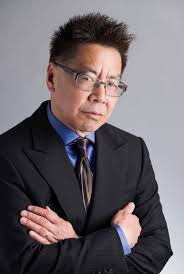
Attachments area

